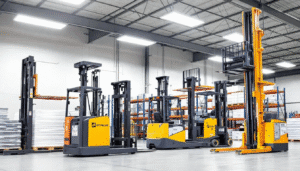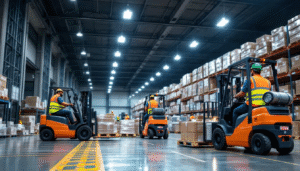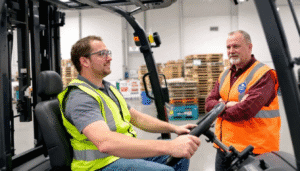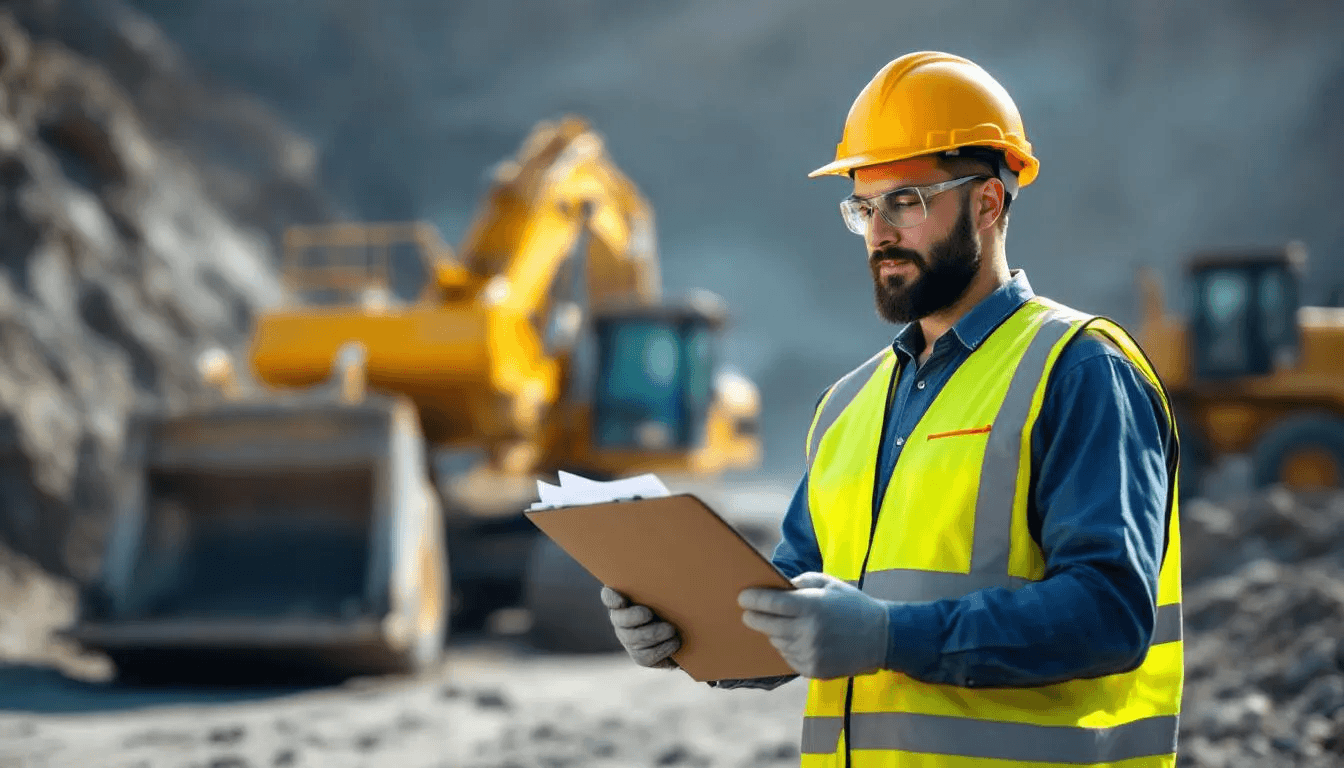
Forklift License: Complete Guide to Getting Your High Risk Work License in Australia
Forklift License: Complete Guide to Getting Your High Risk Work License in Australia
Operating a forklift in Australia requires more than just knowing how to drive – it demands proper certification, safety training, and legal compliance. Whether you’re looking to advance your career in warehousing, construction, or logistics, obtaining a forklift license is your gateway to better job opportunities and increased earning potential.
If you are based in Sydney, there are comprehensive forklift license Sydney training programs available, designed for students and workers seeking industry-relevant skills, safety knowledge, and support to succeed in the local industrial and warehousing sectors. Australian Forklift Training is a registered training organisation (RTO) with locations across Sydney.
This comprehensive guide walks you through everything you need to know about getting your high risk work licence for forklift operation in Australia, from understanding legal requirements to completing the assessment process and maintaining your certification.
We deliver training for the nationally recognised units:
TLILIC0003– Licence to operate a forklift truck
TLILIC0004– Licence to operate an order picking forklift truck
What is a Forklift License?
A forklift license is a high risk work licence required to legally operate a forklift truck in Australia. This mandatory certification is issued by state safety authorities like SafeWork NSW and demonstrates that you have the necessary knowledge and skills to safely operate forklift equipment in workplace environments.
Under the Work Health and Safety (WHS) Regulation 2017, anyone who wants to operate a forklift must hold an appropriate high risk work licence. Safe Work Australia, as the national authority, sets occupational health and safety standards for forklift licensing and provides guidance on compliance with these regulations. This licence is valid for 5 years from the date of issue and is recognised across all Australian states and territories, making it a valuable qualification for workers who may relocate for employment opportunities. To continue working legally in high risk roles, licenses must be renewed before expiration.
The forklift license covers both theoretical knowledge of safety regulations and practical skills for safe forklift operation. This comprehensive approach ensures that licensed operators can identify workplace hazards, calculate loads appropriately, and follow proper safety procedures to protect themselves and their coworkers, in line with occupational health standards that help maintain a safe workplace.

Understanding High Risk Work Licenses
High risk work licenses are a crucial part of Australia’s workplace safety framework, designed to ensure that only qualified individuals operate potentially dangerous equipment such as forklifts. These licenses are issued by state and territory authorities and are mandatory for anyone who wants to operate a forklift truck in a professional setting. A high risk work license is also required for operating specified machinery, erecting scaffolding, and undertaking dogging or rigging work.
To obtain a forklift license, you must complete a comprehensive training course that covers both the theoretical and practical aspects of forklift operation. This includes learning how to safely operate a forklift truck, understanding the risks associated with high risk work, and developing the skills needed to handle equipment in a variety of workplace environments. The process culminates in a practical assessment, where you must demonstrate your ability to operate a forklift safely and competently.
By successfully completing the required training and assessment, you gain the knowledge and skills necessary to operate a forklift, ensuring you can perform high risk work safely and in compliance with Australian regulations. This not only protects you but also contributes to a safer workplace for everyone.
Legal Requirements for Operating a Forklift
To legally operate a forklift in Australia, you must be at least 18 years old and hold a valid high risk work license. Additionally, you need a good understanding of English for both written and spoken communication to obtain a forklift license. Operating forklift equipment without proper certification can result in significant fines and legal penalties for both the operator and their employer.
Employers have a legal obligation to ensure all forklift operators hold appropriate license classes for the specific type of equipment they’re operating. This means that simply having experience with forklifts isn’t sufficient – you must complete formal training through a registered training organisation and successfully pass both theoretical and practical assessments. Only relevant training completed through a registered training organisation qualifies applicants for a high risk work license.
Your license to operate must be readily available for inspection during work activities. Many operators carry their license card with them, while others keep copies in their workplace or vehicle. Some employers also maintain digital copies of their workers’ licenses to ensure compliance during safety inspections.
The penalties for non-compliance can be substantial. Individual operators may face fines of several thousand dollars, while employers can be liable for even larger penalties if they allow unlicensed operators to perform high risk work on their sites.
Eligibility and Requirements for a Forklift License
Before you can enrol in a forklift license course, you must meet certain eligibility criteria. In Australia, you need to be at least 18 years old and have the ability to read and write English, as clear communication is essential for forklift safety and understanding operational instructions.
The next step is to complete a forklift training course with a registered training organisation (RTO). These courses are designed to equip you with the knowledge and practical skills required to safely operate a forklift truck. Training covers essential topics such as forklift safety, correct operating procedures, and effective load handling techniques.
After completing the training, you must pass a practical assessment conducted by a qualified assessor. This assessment evaluates your ability to safely operate a forklift truck in real-world scenarios, ensuring you can apply what you’ve learned in the training course. Only after successfully completing both the training and assessment can you apply for your forklift license and legally operate a forklift in the workplace.
Types of Forklift Licenses in Australia
Australia recognises two forklift license classes, each designed for specific types of equipment and workplace applications. In Australia, there are two types of forklift licenses: LF and LO licenses. Understanding which license you need is crucial for ensuring you can legally operate the equipment required for your job.
It is important to note that slewing mobile cranes and typical earthmoving equipment such as front end loaders, backhoes, or excavators are not covered by standard forklift licenses.
LF License – Standard Forklift Truck
The LF license allows you to operate standard forklifts with a mast and elevating load carriage. This is the most common forklift licence for warehousing, construction sites, and general industrial applications.
This licence class covers forklifts equipped with fork arms or other attachments such as clamps, rotators, or specialised lifting equipment. Most warehouse and construction workers who need to move pallets, building materials, or heavy equipment will require an LF license.
However, it’s important to note that the LF licence does not authorise you to operate order-picking forklift trucks where the operator platform elevates with the load. These require a separate LO licence class.
LO License – Order-Picking Forklift Truck
The LO licence is required specifically for order-picking forklift trucks where the operator controls and platform elevate with the load carriage. This is a distinct licence class separate from the standard LF licence.
Order picker operations are essential in warehouse and distribution center environments where workers need to access high storage areas to pick individual items or small quantities. The operator platform moves up and down with the lifting mechanism, allowing precise placement and retrieval of goods at various heights.
Many large retailers, e-commerce fulfillment centers, and logistics companies require workers to hold LO licences for their daily operations involving inventory management and order fulfillment.

How to Get a Forklift License
Obtaining your forklift licence typically takes 2 days and involves completing training with a registered training organisation, passing both written and practical assessments, and submitting your application via Service NSW. In many regions, you can also apply online for your assessment enrolment number and high risk work licence, making the application process more convenient. Here’s the step-by-step process to get licensed.
Step 1: Complete Training with Registered Training Organisation (RTO)
Your first step is to enroll with a SafeWork-approved registered training organisation rto that offers forklift courses. These organisations are authorised to conduct training and assessment for high risk work licences and maintain the standards required by australian state safety authorities.
Before attending your forklift licence course, you’ll need to complete any pre-course materials and assignments provided by your RTO. Most training providers offer online components that cover basic safety principles and regulatory requirements.
You must be fluent in English, both written and spoken, as translators are not permitted during the assessment process. This ensures that all operators can understand safety instructions, read warning signs, and communicate effectively in emergency situations.
When attending your training course, bring appropriate personal protective equipment including hi-vis clothing, closed-toe shoes, and any other safety gear specified by your RTO. Students must wear personal protective equipment (PPE) during forklift training. This equipment is essential for the practical exercises you’ll complete during training.
Step 2: Attend Training Course
The first day of your forklift course typically covers theoretical knowledge including safety regulations, load handling principles, and proper forklift operations. You’ll learn about workplace hazards, risk management strategies, and the specific characteristics of different forklift types.
Practical training takes place on actual forklift equipment in simulated workplace conditions. This hands-on experience teaches you proper pre-operational checks, maintenance procedures, and safe operating techniques for navigating obstacles and moving loads.
Your instructor will demonstrate correct procedures for calculating loads, ensuring safe lifting practices, and responding to emergency situations. This practical component is essential for developing the skills needed to safely operate a forklift truck in real workplace environments.
Training also covers the importance of regular equipment inspection, understanding forklift controls, and recognising when equipment requires maintenance or repair. These skills help prevent accidents and ensure equipment longevity.
Step 3: Pass Assessment
Day two of your forklift training involves both written knowledge tests and practical skills assessment. The assessment process is designed to verify that you have achieved competency in all aspects of safe forklift operation. Forklift training courses are usually conducted over two days, with theory and practical learning on day one and assessments on day two. Australian Forklift Training offers free retesting and training to ensure all students can achieve competency.
The written component tests your understanding of safety regulations, load calculation principles, and proper procedures for various forklift operations. You’ll need to demonstrate knowledge of workplace safety requirements and hazard identification.
The practical assessment must be conducted by a SafeWork-accredited assessor, with a SafeWork assessor present to oversee the assessment and ensure compliance with national safety standards. This includes pre-operational checks, load handling, maneuvering in tight spaces, and emergency procedures. Forklift training must be conducted by a qualified instructor who holds the appropriate teaching license.
Upon successful completion of both assessment components, you’ll receive an email from Service NSW and will need to pay the licensing fee online.
Submit Application Within 60 Days
Pay and lodge your completed license application form via Service NSW. The 60-day deadline is strict – applications submitted after this period become void and require you to repeat the entire assessment process. You must submit your forklift license application within 60 days of completing your training and assessments. License renewals can be completed within 12 months after expiration without retaking the assessment.
Staff at Service NSW will verify your documents and process your application for submission to the relevant state safety authority. Make sure all information is accurate and complete to avoid processing delays.
Processing and Issuance
Once submitted, SafeWork processes your application and verifies your assessment results with the registered training organisation that conducted your training. This verification process ensures the authenticity of your qualification.
Your high risk work license will be issued and mailed to your registered address once processing is complete. Typical processing times are 10-15 business days, though this can vary during peak periods or due to postal delays.
The license is valid for exactly 5 years from the issue date, regardless of when you completed your training or submitted your application. This means early application doesn’t reduce your license validity period.
Keep your license in a safe place and consider making copies for your employment records. Many workers also take photos of their license with their mobile phone for quick reference when needed.
Regional Requirements for Forklift Licenses
While the core requirements for obtaining a forklift license are consistent across Australia, there are some regional differences in how the process is administered. Every state and territory requires individuals to hold a high risk work license to operate a forklift truck, but the specific steps and approved training providers may vary.
For example, in NSW, you must complete your forklift training with a SafeWork NSW-approved registered training organisation and pass a practical assessment to qualify for a forklift license. Other states and territories have their own lists of approved RTOs and may have slightly different processes for submitting your application or completing your assessment.
Regardless of your location, the fundamental steps remain the same: complete a forklift training course, pass the practical assessment, and apply for your high risk work license. It’s important to check the requirements in your specific region to ensure you meet all local regulations and complete the process correctly.
License Renewal and Maintenance
Maintaining your forklift license requires attention to renewal deadlines and keeping your contact information current with the licensing authority. It is important to submit your renewal application before your license expires to maintain continuous authorisation. Understanding the renewal process helps ensure continuous authorization to perform high risk work.
5-Year Validity Period
All forklift licenses expire exactly 5 years from their issue date. The licensing authority sends renewal reminders 60 days before expiry via email or text message to your registered contact details.
You can renew your license up to 12 months after the expiry date without requiring retraining or reassessment. However, renewal applications beyond this period require you to complete training and successfully complete the entire assessment process again.
If you’ve added additional license classes during your 5-year period, all licenses expire simultaneously with your original license. This coordinated expiry date simplifies the renewal process for operators who hold multiple high risk work licenses.
Renewal Process
The license renewal process can typically be completed online in approximately 5 minutes. This convenient option allows you to renew from anywhere with internet access without visiting physical offices.
No reassessment is required for standard renewals, making the process straightforward for operators who maintain their skills and comply with safety requirements. However, if you’ve had safety incidents or violations, additional requirements may apply.
Alternative renewal options are available through Service NSW offices or SafeWork locations if you prefer in-person service or need assistance with the renewal process. These offices can also help update your contact details and answer questions about license requirements.
Remember to update your contact details with the licensing authority whenever you move or change phone numbers. This ensures you receive renewal reminders and important safety notifications.

Industries Requiring Forklift Licenses
Forklift licenses are mandatory across numerous industries where workers need to move heavy materials, navigate confined spaces, or stack goods at height. Understanding which sectors require certification helps you identify potential career opportunities.
Warehousing and Distribution Centers employ the largest number of licensed forklift operators. These facilities require workers who can efficiently move pallets, navigate narrow aisles, and safely stack products at various heights.
Manufacturing and Food Processing Facilities need operators to transport raw materials to production lines and move finished goods to storage areas. Many employees in these industries find that holding a forklift license significantly improves their job prospects.
Construction Sites require operators to move building materials, equipment, and supplies around work areas. The ability to safely operate forklifts on uneven surfaces and in challenging conditions is highly valued.
Retail Stores with large inventory footprints, particularly hardware stores and bulk retailers, need licensed operators for their backroom operations and customer loading areas.
Ports and Container Handling Facilities offer specialised opportunities for operators with reach stacker licenses, working with shipping containers and international cargo.
Mining and Resource Extraction Operations provide some of the highest-paying opportunities for licensed forklift operators, often in remote locations with attractive compensation packages.
Benefits of Having a Forklift License
Obtaining your forklift license opens doors to numerous career advancement opportunities while providing tangible benefits for both your professional development and earning potential.
Licensed forklift operators often earn 20-30% more than unlicensed warehouse workers, making the investment in training and certification financially beneficial. This premium reflects the specialised skills and safety responsibility that comes with operating heavy machinery.
Career Advancement Opportunities abound in logistics, warehousing, and manufacturing sectors. Many supervisory and management positions prefer or require candidates with operational experience and safety certifications.
Increased Workplace Safety through proper training reduces the risk of accidents and injuries. Licensed operators understand how to identify hazards, properly calculate loads, and follow safety protocols that protect everyone in the workplace.
Job Security in high-demand industries provides stability even during economic uncertainties. The growth of e-commerce and logistics means skilled forklift operators remain in constant demand.
Transferable Skills are recognised nationwide, allowing you to pursue opportunities across different states and territories without additional certification requirements.
Reduced Workplace Accidents benefit both operators and employers through lower insurance costs, fewer workers’ compensation claims, and improved safety records that attract better clients and contracts.
Is Forklift Training Hard to Pass? A Complete Guide to Certification Success
Training Costs and Course Fees
The investment in forklift training typically ranges from $375-$475 depending on your location, the training provider, and whether you’re seeking single or multiple license classes. This cost includes both theoretical and practical instruction, assessment, and the Notice of Satisfactory Assessment. Reputable training providers are transparent about pricing and do not charge hidden fees beyond the stated course and licensing costs.
Additional fees apply for the license application process via Service NSW, including government licensing fees that vary by Australian state. Some locations also charge processing fees for application handling and license production.
Many registered training organisations offer payment plans and Afterpay to help students manage the upfront costs, particularly for individuals paying privately rather than through employer-sponsored training. Group discounts may be available for companies training multiple employees simultaneously.
Employer-Sponsored Training is common in industries with high forklift usage. Many companies invest in employee certification as part of their safety compliance and workforce development programs, recognising the cost savings from reduced accidents and improved efficiency.
The return on investment typically occurs quickly, with increased earning potential often recovering training costs within the first few months of employment. Consider this certification an investment in your long-term career prospects rather than just an immediate expense.

Additional Resources and Support
If you’re preparing to obtain your forklift license, there are a range of resources and support services available to help you succeed. Many registered training organisations offer flexible forklift training options, including online training courses, hands-on practical sessions, and comprehensive assessment services.
Student support is a key feature of reputable RTOs, with services such as language, literacy, and numeracy assistance to help you complete your training course and meet the assessment requirements. These support services ensure that all students, regardless of background, have the opportunity to safely operate a forklift truck and achieve their license.
For further information about forklift license requirements, training courses, or assessment processes, you can contact your state or territory workplace health and safety authority. These organisations provide up-to-date guidance on compliance, available courses, and any changes to licensing regulations. By taking advantage of these resources and completing your forklift training, you’ll gain the skills and knowledge needed to safely operate a forklift and contribute to a safer, more efficient workplace.
Forklift Licence Sydney: Complete Guide to Getting Your Certification in 2025
Frequently Asked Questions
Understanding common questions about forklift licensing helps clarify the process and requirements for prospective operators.
What support is available if I have trouble with the assessment requirements?
If you need help meeting the assessment requirements, dedicated support officers are available to assist with language, literacy, and numeracy requirements. This support is provided free of charge to help you succeed in your course.
Do I need a driver’s license to get a forklift license?
No, you don’t need a driver’s license to obtain a forklift license. These are completely separate qualifications with different requirements and applications. You can legally operate a forklift truck without holding a car license, as the focus is on forklift-specific skills and safety knowledge rather than general driving ability.
The forklift training course teaches equipment-specific skills including load calculation, stability principles, and workplace safety that are quite different from passenger vehicle operation. However, having general driving experience may help with spatial awareness and vehicle control concepts.
Can I use my forklift license in other states?
Yes, Australian forklift licenses are valid nationwide across all states and territories. You don’t need to reapply for a new license when moving between locations for work or residence.
However, you should update your address with the licensing authority in your new state of residence to ensure you receive renewal notifications and other important communications. This administrative step helps maintain continuous compliance with safety requirements.
Forklift Driving Lessons: Private one on one training
What happens if I fail the assessment?
Most registered training organisations offer unlimited free retesting and additional training until you demonstrate competency. The goal is student support and successful completion rather than failing students who need more time to develop their skills.
You can retake both written and practical assessments until you successfully complete all requirements. Additional support is available for students with language or literacy needs, ensuring that everyone has the opportunity to achieve competency regardless of their educational background.
If you’re struggling with specific aspects of the assessment process, speak with your instructor about additional practical exercises or further information about challenging topics. Remember, the assessment is designed to ensure workplace safety, not to prevent people from obtaining their license.
The comprehensive training provided by quality registered training organisations prepares students thoroughly for the assessment process, and most people pass on their first attempt. However, the option for additional training and retesting ensures that everyone can achieve the competency needed to safely operate forklift equipment in their chosen career.
Author:
Simone Rennocks, MA in Analytical Psychology, Certificate IV in Training & Assessment, BA in Fine Arts
Last updated: 29 July 2025
Simone is the founder and lead trainer at Aus Forklift Training, a Registered Training Organisation (RTO ID: 91037) delivering accredited forklift licensing and vocational training in Sydney.
Locations: Blacktown – 1/3-5 Tattersall Road | Moorebank – 7/30 Heathcote Road
Phone: 02 8814 8640 | Contact us: https://ausforklifttraining.com.au/contact-us
View our LF Forklift Licence Course → https://ausforklifttraining.com.au/forklift-licence-course
Quick links to resources:
- Can You Fail a Forklift Licence? → “Stay current with a VOC verification
- Forklift Safety: Common Mistakes to Avoid → “Stay compliant through our VOC forklift page


